Fig. 12.
Directional masking ABR methodology. (A) ABRs are recorded in response to a brief broadband stimulus (S) in the presence and absence of a continuous tone masker (M, dark blocks). Stimuli are presented in trains of eight clicks with alternating polarity. (B) Responses from 400 presentations are averaged for both the stimulus (S) and stimulus plus masker (S+M) conditions. Sensitivity to the masker tone is computed by subtracting the averaged signals. The resulting differential signal is normalized to the amplitude of the stimulus response. (C,D) Digital recording (C) and power spectrum (D) of positive polarity modified click spectrum. The stimulus has been optimized so that the power spectra of the audible signal was relatively flat over the test frequencies and the amplitude was at the lowest level needed to produce a maximal response. (E) Directional sensitivity was measured by rotating the heading direction of the animal with respect to the masker sound source. The animal was restrained on a foam plank and placed on a rotating table. Attached to the table was an arm holding the stimulus speaker (S) 0.6 m from the center of the animal's head. A second, larger speaker, 3 m from the animal's head, was used to play the masker tones (M). Recordings were made with the animal facing eight heading directions (X). The placement of the recording electrode is identified with a star. (E is not drawn to scale.)

